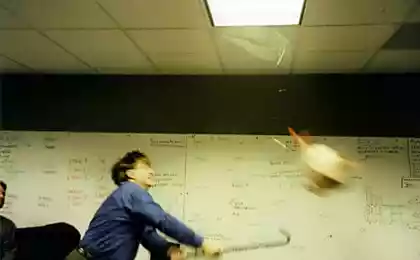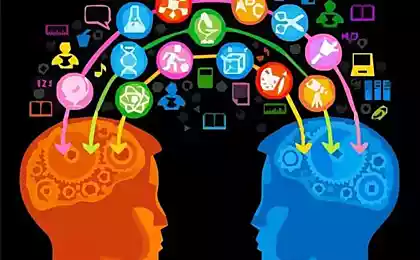2920
Neurological levels

The theme of "logic level" was developed by Robert Dilts as a generalization of the ideas put forward by the major philosophers of the twentieth century Gregory Beytsenom and Bertrand Russell.
Man has long sought to establish and organize different kinds of hierarchy (social, value, cognitive, and so on). Even to choose your own food in a great supermarket, we should have some preferences, that is to create within themselves "subjective disparity" between the proposed products (otherwise we would have to buy anything or die of starvation :)). Preferences gradually form an opinion, and each of them can be on different logical levels.
R.Dilts pyramid suggested the following logic levels (see. Figure)
It operates in relation to the "Law of the Pyramids": "The changes taking place at a low logic level, almost never leads to changes at a high logic level; a change occurring at a higher level, almost always leads to changes at lower levels. " Persuasion "closed shop because there repair" affects me much less than the belief "I never get what I want." In general, one can say that beliefs have a stronger influence as they become 1). more generalized and 2). more individual. Quite different sound proposition: "I have a car" (the level of the environment), "I know how to drive a car" (level of ability) and "I - a man who can not do without a car" (level of personal A peculiar). Is likely to be a big difference in the thinking and behavior of two people, one of them says: "I had a child," and the other says, "I became a father." When a person is convinced that he - a failure, rather than just randomly did not the right move, it has on it a far greater impact. From the point of view of NLP model logic level is very important to select the ways of working with the client. Generally, any effective solution to the problem is at a high logic level. For example, if someone tells you that he is upset that left him a girlfriend (changes at the level of environment and behavior), you can remind him of what had remained of his ability to love and build relationships.
Description levels
At acquaintance with logic levels first thing comes to mind is a known human characteristic - to lay everything on the shelves. Continuing the analogy, we can say that the study of the levels of the pyramid - a good way to learn self & quot; «wardrobe» & quot ;, with all its shelves. The model focuses on Robert Dilts and the system itself arrangement of shelves, and what and where is. Such knowledge is very useful in practice. Especially when all sort through, and what and where in particular - have already forgotten. Each & quot; «shelf» & quot; this & quot; «cabinet» & quot; designed to store quite a specific kind of information. That is, each logical level represents a unique set of categories of subjective experience. Let's see what lies behind the names of the levels?
& Quot; «The level of environment
includes specific external conditions in which there are your behavior and interaction »& quot ;, - the author introduces the definition of the model. Following the definition, we supplement it with information from the Soviet Encyclopaedia: & quot; «environment - the habitat and human activity, the surrounding natural and man he created material world» & quot ;.
How to say the new Russian is & quot; «very specific» & quot; level. Anything that can be expressed in words on this level, answers questions the popular TV show: & quot; «What? Where? When? »& Quot; and other such vital questions, such as: & quot; «Who? Who? »& Quot ;. At its core level environment describes some territory, & quot; «habitat» & quot; person.
Level environment - a set of categories of experience with the property static (ie, unchanging in time). Time at this level - just another dimension to clarify the position in relation to the present. There is no movement. Movement is above the action level.
& Quot; «This level refers to the behavioral activities or results within the environment - t. E. Suggests that happened, where and with whom» & quot ;, - describes the action level Encyclopedia of NLP.
Action level
often in the literature is called the level of behavior. Collegiate Dictionary defines the behavior as & quot; «inherent in living beings interact with the environment, including their motor activity and orientation with respect to the environment» & quot ;. Thus, the level corresponding to the question & quot; «What does?» & Quot ;, is dedicated to information about the changes and movements express different verbs. There is implicit as an indicator of the speed of movement. I go - one speed. I run - a different speed. I rush at full speed - third speed. At this level, time - not further coordinate and measure changes. It turns out that the level of action corresponds to the tasks similar to those set itself kinematics - the branch of theoretical mechanics, where he studied only the mechanical motion of bodies without analyzing the movement determining the conditions and causes.
Conditions and causes movement to be found at the level of abilities.
Ability to Encyclopaedia - a & quot; «individual personality traits are the subjective conditions for the successful implementation of a certain kind of activity» & quot ;.
& Quot; «Much of our behavior comes from" "mental map» & quot; and other internal processes whose resources are inside our mind. This is the level of experience that is behind your direct perception of the environment & quot; & quot ;, - R. Dilts defines the contents of this level.
At this level, NLP includes different algorithms and strategies behind the behavior and answer the question & quot; «How?» & Quot ;. It also includes various states, which are resources in the implementation of strategies. Ability - a kind of engines, the internal forces of our behavior, sources of traffic.
The answer to the question: & quot; «What causes these forces?» & Quot; - Is at a higher level of beliefs and values.
R. Dilts writes: & quot; «Your beliefs and values are beyond the individual thoughts and serve to maintain, suppression or generalized entire strategies, plans and directions of reasoning» & quot ;.
This level is interesting because his example can trace the evolution of the model logic levels and feel that this model is a living and evolving under the influence of practice.
Originally included only the name of the level of persuasion. Then he appeared in the title of beliefs and values as a union. Further, as for the practice needed more to distinguish beliefs and values to distinguish two distinct sublayers: the beliefs and values of the sublevel. Each of them has its own unique and important. However, they have not identified as separate layers together and coexist. Here we consider them separately.
Beliefs.
In the encyclopaedia, oddly enough, there is no definition of the term & quot; «conviction» & quot ;. No such determination even in the philosophical dictionary Soviet times. This is even more fun if we remember that all last era we fought for their beliefs, and fought for, is not even defined.
Forced to turn to other sources. In the dictionary of the Russian language has two definitions, a high degree of generalization: & quot; «conviction - a hard look at anything, formed on the basis of any ideas» & quot; and & quot; «belief - a belief system, ideology» & quot ;. More detailed definition is attributed to Socrates: & quot; «beliefs - a" "reflexes» & quot; man, his fixed reaction to these or other aspects of life & quot; & quot ;. Robert Dilts gives another definition: & quot; «Persuasion - this is a generalization of a relationship between the manifestations of life experience» & quot ;.
We are talking about some stable connection, answering the question & quot; «Why? How is interconnected? »& Quot ;. This is a cause-and-effect relationships, for example: & quot; «If I'm healthy, I can help others» & quot ;, or logical relations, using comparison operators, for example: & quot; «Red apples better green» & quot ;. A special case is the equality: & quot; «that in his forehead, that on his forehead - all one» & quot; or equivalent: & quot; «smoking [identically equal to] harmful» & quot ;. In addition, the disposal of the level of the entire set of beliefs and logic, and algebraic operations, which can only be found in the arsenal of mathematics.
The very model of logical levels - a typical example of experience at the level of belief because (see. The beginning of the article) model operates on relations between the elements of subjective experience.
At this level, as in conventional math, you can do the arithmetic, that is connecting the elements of sensory experience, or algebra, moving from & quot; «specific numbers» & quot; to certain variables, touch the essence of which is not defined or is substituted then after transformation or not substituted at all. We are talking about nominalization, language facilities, deprived of sensory experience. These objects are often rightly considered harmful and fight them using a metamodel. However, without such & quot; «algebraic variables» & quot; our experience is the same & quot; «equation problems» & quot; new & quot; «specific numbers» & quot; would constitute for us every time new, and we would have to find a way to solve it again, wasting time and resources.
Values.
Here is the source of the variables used in convictions. This is the realm of nominalization and concepts that have very large scale generalizations and having the main feature - significance.
According to the Encyclopedic Dictionary, & quot; «value - positive or negative significance of the objects of the world to rights, social groups and society as a whole, which is determined not by their properties in themselves, and their involvement in the sphere of human activity, interests and needs, social relations" & quot ;. That importance is the key to understanding the level corresponding to the question & quot; «Why is it so important?» & Quot;
Values are similar to the foundation piles or personal experience. Piles are interconnected beliefs that support the values. The entire structure as a whole forms a plinth of the building, which is called the personal originality, or identity.
Identification.
Encyclopedia of NLP: & quot; «The level of identity reduces the system of beliefs and values in the sense of self identity ... Level specifies how the personal role of self-awareness or related problem or result:" "Who is supposed to get involved? What beliefs, values, skills and behaviors associated with different roles? »& Quot;
Adding to this encyclopedic dictionary definition: & quot; «identity - a stable system of socially significant features that characterize the individual as a member of the society or community» & quot ;, we obtain a comprehensive description of the categories of experience are at this level.
If the logic level of beliefs and values - there is a certain algebra of human experience, then, continuing parallel with mathematics, the level of identity - a kind of topology. Topology - generalized geometry, classifying different shapes and their properties as whole objects. In ordinary geometry squares, circles and triangles - unique in the sense of the topology of shapes with unique properties. Similarly, at the level of identity & quot; «Businessman» & quot ;, & quot; «Family Man» & quot ;, & quot; «professional» & quot; - Some unique role with its unique qualities.
And the level of identity - is the level name. The main criterion imposed in the header level - identity. As in the novel Le Guin U. & quot; «Wizard of Earthsea» & quot; knowledge of the true names of the surroundings makes the wizard aptitude and NLP - to know the names of individual parts of the personality gives the consultant the opportunity to carry out the most rapid change. As in a conventional programming identifiers are used for access to information, and in NLP on this logical level identifiers are located very large integrated complex of our experience.
For which are given unique names? For what defines a unique integrity? For which played that role? The answer lies in the higher logical levels.
Level mission and transmission Robert Dilts combines into a single level & quot; «Spiritual» & quot ;, which can be translated as & quot; «spiritual» & quot ;: & quot; «In the end, there is a living, including the fact that, as a rule, concerns "" Spiritual »& quot; experience. This refers to your sense of something that is beyond your personal vision of himself and includes your vision of larger systems surrounding specific roles, values, beliefs, thoughts, actions, or feelings ... This level refers to what may be a vision or & quot; "spirit» & quot; individual, group or organization & quot; & quot ;.
In practice, of & quot; «spiritual» & quot; level is allocated a special independent logic level. It is called & quot; «Mission» & quot ;.
Mission.
By definition, an encyclopedic dictionary & quot; «mission (from Lat. Missio - premise, order) - the delegation sent in others. Country with a specific request» & quot ;. The definition does not exactly, but rather, metaphorically clarifies the essence of the experience gathered at this level. The main selection criterion is the keyword & quot; «a certain order» & quot ;. This level routes through the & quot; «map, which is not the territory» & quot ;. This is a strategic level, to answer questions: & quot; «Why? For what? What is the meaning? »& Quot ;. Answers to questions on the level of strategic missions allow to select the experience necessary to carry out the mission - from the required roles and ending with the specific sensory audited environment. Model of this process is embodied, for example, in computer games RPG, where knowing the problem and route how to go, you can choose a suitable hero warrior, mage or thief, ask the necessary & quot; «skills» & quot; -sposobnosti and pick right arms-environment.
If you continue & quot; «scientific» & quot; metaphor, the level of mission opens levels of philosophical and metaphysical experience concerning systems larger than an individual or identity























